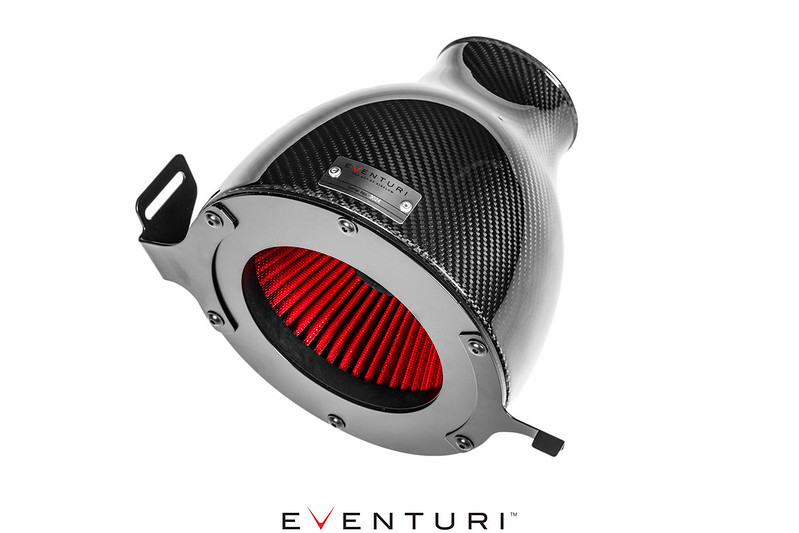Eventuri Carbon Fibre Intake System – Audi RS3 8V (Pre-Facelift) – EVE-8VRS3-CF-RHD-INT
Performance Gain: 17-20hp, 22-25ft-lb
V-Box Acceleration : 60-130mph Reduced By 0.3 Seconds
The Audi 8V RS3 Eventuri intake sets a new benchmark in aftermarket intake design for this platform. It was developed to achieve two objectives – 1) De-restrict the turbo inlet path. 2) Maintain low inlet temperatures. The first objective was met by using 88mm internal diameter tubing all the way to the turbo as well as using our unique Venturi housing to maintain laminar flow. The second objective was met by designing a sealed system to the stock cold air feed therefore ensuring the turbo does not draw heated air from the engine bay. The intake duct draws air from the stock feed and has been maximised in volume to allow the highest flow rate through the filter. The resulting performance gains and aesthetics are industry leading for the 8V RS3.
The Eventuri Difference
The 8V RS3 Eventuri system uses our Patent Pending Carbon fibre Housings which provide an aerodynamically efficient airflow path from the filter to the turbo tubing. Not just another cone filter with a heat shield but a unique design which invokes the Venturi affect.
The Eventuri 8V RS3 intake system consists of a number of components engineered to perform a specific purpose and fabricated to the highest of standards. Here are the details for each component and the design ethos behind them:
Each intake system consists of:
- Carbon Fibre Venturi Filter Housing
- High Flow Urethane Cone Filters
- Carbon Fibre inlet Duct
- Carbon Fibre or Metal Turbo Tube
- Carbon Fibre Connecting Tube
- Laser Cut Stainless Steel Brackets
- Silicon Couplers and Reducer
Carbon Intake Housing Assembly

The filter housing comprises of a high flow filter, aluminium cowl, laser cut brackets and the carbon pod itself. The carbon pods shroud the reverse mounted filter and smoothly shape the airflow down to the intake tubes. This smooth reduction in cross sectional area invokes the Venturi effect where the airflow accelerates whilst maintaining laminar conditions. It can be thought of as a large velocity stack – below is a diagram to show the comparison between our patent pending design and a regular intake system. Further details can be read in the Technology page.

Carbon Fibre Intake Duct

The duct channels ambient air from the slam panel area to the filter housing. It fits inside the OEM ducting system and smoothly transitions to the circular filter housing shape. In order to ensure a good seal against engine bay heat – it also has a flexible rubber edging around the opening which presses against the filter housings creating the desired seal yet allowing the housing to move with the engine. The duct was designed to have the maximum internal volume possible within the given geometry of the engine bay. This ensures that the filter housing is able to draw with minimum restriction.
Performance
Extensive testing was carried out on this system both on the Dyno and road. Firstly the dyno tests were carried out showing an impressive gain of approximately 17hp and 25ft-lb of torque. The gain is not just at the peak but throughout the RPM range. This translates on the road to increased part throttle and full throttle response with the car pulling much more eagerly to the redline. The testing was done on the same day back-to-back and temperatures were monitored to ensure consistency. The car was tested firstly with the stock intake – hood closed. We then left the car on the dyno and installed the Eventuri. The car was then run again – hood closed. Several runs were carried out with both configurations to get a consistent result.

We then took the car for some road testing using a Vbox unit to record the acceleration from 60-130mph (also 100-200Km/h). Testing was carried out on the same stretch of road – again on the same day to keep variables minimum. Results show that with just the intake added, the acceleration times from 60-130mph and also 100-200Km/h reduced by approximately 0.3 seconds which is a significant change at such speeds.
Acceleration results summary:
- 60-130mph with Stock intake = 12.013 seconds
- 60-130mph with Eventuri intake = 11.753 seconds
- 100-200Km/h with Stock intake = 10.271 seconds
- 100-200Km/h with Eventuri intake = 10.046 seconds








































